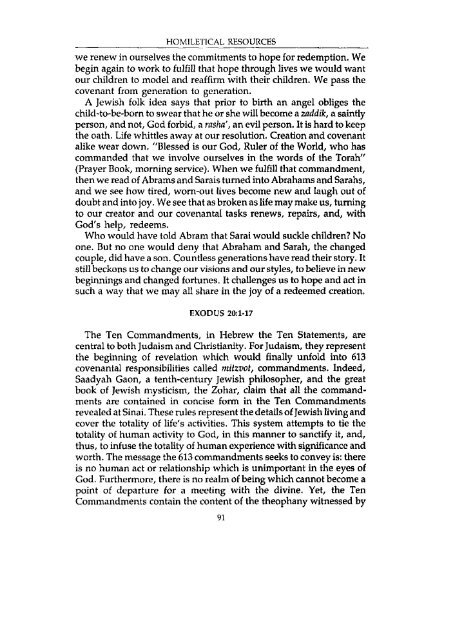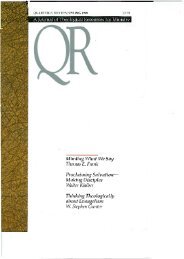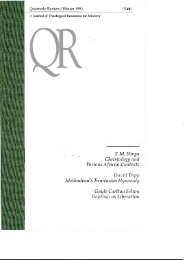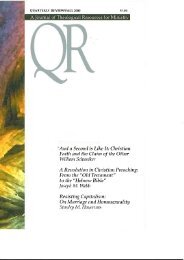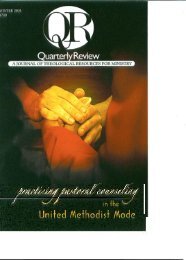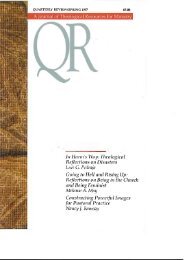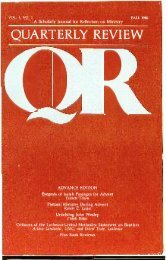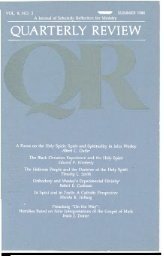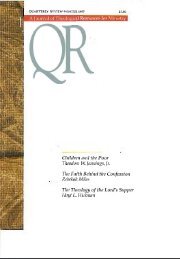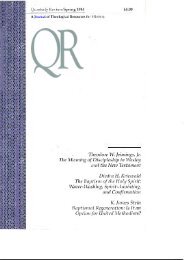Winter 1984 - 1985 - Quarterly Review
Winter 1984 - 1985 - Quarterly Review
Winter 1984 - 1985 - Quarterly Review
Create successful ePaper yourself
Turn your PDF publications into a flip-book with our unique Google optimized e-Paper software.
HOMILETICAL RESOURCES<br />
we renew in ourselves the commitments to hope for redemption. We<br />
begin again to work to fulfill that hope through lives we would want<br />
our children to model and reaffirm with their children. We pass the<br />
covenant from generation to generation.<br />
A Jewish folk idea says that prior to birth an angel obliges the<br />
child-to-be-born to swear that he or she will become a zaddik, a saintly<br />
person, and not, God forbid, a rasha', an evil person. It is hard to keep<br />
the oath. Life whittles away at our resolution. Creation and covenant<br />
alike wear down. "Blessed is our God, Ruler of the World, who has<br />
commanded that we involve ourselves in the words of the Torah"<br />
(Prayer Book, morning service). When we fulfill that commandment,<br />
then we read of Abrams and Sarais turned into Abrahams and Sarahs,<br />
and we see how tired, worn-out lives become new and laugh out of<br />
doubt and into joy. We see that as broken as life may make us, turning<br />
to our creator and our covenantal tasks renews, repairs, and, with<br />
God's help, redeems.<br />
Who would have told Abram that Sarai would suckle children? No<br />
one. But no one would deny that Abraham and Sarah, the changed<br />
couple, did have a son. Countless generations have read their story. It<br />
still beckons us to change our visions and our styles, to believe in new<br />
beginnings and changed fortunes. It challenges us to hope and act in<br />
such a way that we may all share in the joy of a redeemed creation.<br />
EXODUS 20:1-17<br />
The Ten Commandments, in Hebrew the Ten Statements, are<br />
central to both Judaism and Christianity. For Judaism, they represent<br />
the beginning of revelation which would finally unfold into 613<br />
covenantal responsibilities called mitzvot, commandments. Indeed,<br />
Saadyah Gaon, a tenth-century Jewish philosopher, and the great<br />
book of Jewish mysticism, the Zohar, claim that all the commandments<br />
are contained in concise form in the Ten Commandments<br />
revealed at Sinai. These rules represent the details of Jewish living and<br />
cover the totality of life's activities. This system attempts to tie the<br />
totality of human activity to God, in this manner to sanctify it, and,<br />
thus, to infuse the totality of human experience with significance and<br />
worth. The message the 613 commandments seeks to convey is: there<br />
is no human act or relationship which is unimportant in the eyes of<br />
God. Furthermore, there is no realm of being which cannot become a<br />
point of departure for a meeting with the divine. Yet, the Ten<br />
Commandments contain the content of the theophany witnessed by<br />
91


